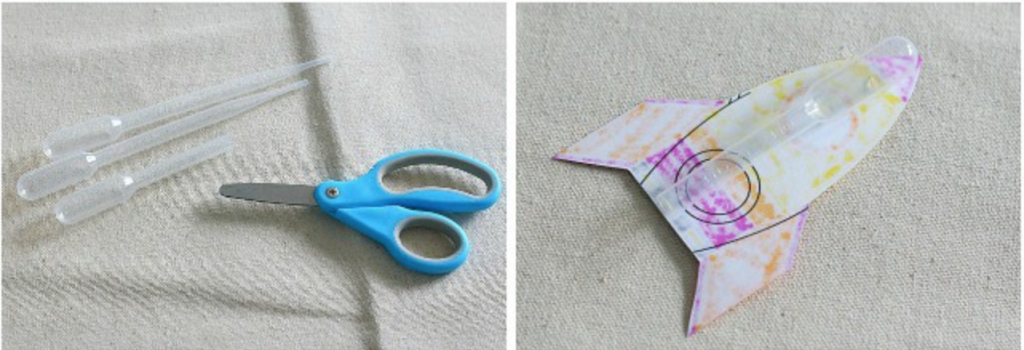Be a Rocket Scientist!
In this lesson, children will learn scientific facts as they follow the book, “If You Decide to Go to the Moon,” which documents a boy’s fascinating excursion to the moon and back. The children will then construct and launch straw rockets to learn about the physics of space.
Content Area:
Earth, Water and Air
Learning Goals:
This lesson will help toddlers and preschoolers meet the following educational standards:
- Develop beginning skills in the use of science and engineering practices such as observing, asking questions, solving problems and drawing conclusions
Learning Targets:
After this lesson, toddlers and preschoolers should be more proficient at:
- Expressing wonder and curiosity about their world by asking questions and solving problems
- Developing and using models to represent their ideas, observations and explanations through activities such as drawing or building
- Carrying out simple investigations
- Using mathematical and computational thinking
- Generating explanations and communicating ideas and/or conclusions about their investigations

Be a Rocket Scientist!
Lesson plan for toddlers/preschoolers
Step 1: Gather materials.
- Free Rocket Template
- The book, If You Decide to Go to the Moon, by Faith McNulty
- Crayons/markers
- Plastic pipettes
- Tape or glue dots
- Scissors
- Straws
- Make copies of the downloaded four-rocket template. Cut the template into four parts and give one rocket template to each child to color and cut out. Some of the younger children will need help cutting their rockets out of the template after they are done coloring.
Note: Small parts pose a choking hazard and are not appropriate for children age five or under. Be sure to choose lesson materials that meet safety requirements.
Step 2: Introduce activity.
Read the book, If You Decide to Go to the Moon, by Faith McNulty
- Ask: “How is the moon different from the earth?”
- Ask: “What is an astronaut?”
- Discuss: “What would you need if you went to the moon?”
Step 3: Engage children in lesson activities.
- Print out the free rocket template.
- Instruct the children to color in their rockets and cut them out.
- Cut the bottoms off of the plastic pipettes and attach them to the backs of the paper rockets with tape: See photos below:

- Slip the straws into the bottoms of the pipettes, and the rockets are ready to launch! If you’re having trouble picturing this, click on the link in the WEB RESOURCES section at the end of this lesson for step-by-step photos and instructions.
- Count down to blast-off: “Five, four, three, two, one. BLOW!”
- Give the students a few minutes to practice blowing through the straws to launch their rockets.
- After all of the rockets have been launched, invite the children to share their reflections on the activity.
- Ask: “What rockets flew the farthest? What would you do differently if you made another rocket?”
Step 4: Vocabulary.
- Astronaut: A person trained for space flight
- Binoculars: A pair of matched telescopes that are held in front of the user’s eyes to see far-away things more clearly
- Comet: An object that orbits the sun
- Gravity: Heaviness or weight
- Hatch: An opening or door in a spacecraft
Step 5: Adapt lesson for toddlers or preschoolers.
Adapt Lesson for Toddlers
Toddlers may:
- Need help assembling the rockets or use rockets that you have pre-assembled
Child care providers may:
- Pair the toddlers up with older children: The toddlers can serve as the “astronauts” who pilot the launched rockets back to the older children who are serving as the rocket launchers.
Adapt Lesson for Preschoolers
Preschoolers may:
- Team up! One child can launch the rocket and other team members can measure the distance that the rocket flies with a ruler or a tape measure. Switch roles so that every team member gets a chance to launch a rocket.
Child care providers may:
- Extend this activity by drawing a chalk circle outside to see who can land their rocket on the “moon.” Measure the distance of the flights. Document the distance.
Suggested Books
- The Darkest Dark by Chris Hadfield (another great book by the rock and roll astronaut)
- Mousetronaut by Mark Kelly (Yes, that Mark Kelly, the astronaut who took mice to the moon and wrote about it!)
- The Astronaut With a Song for the Stars: The Story of Dr. Ellen Ochoa by Julia Finley Mosca
Music and Movement
- Hey-Ho, to Mars We’ll Go! by Susan Lendroth (author) and Bob Kolar (illustrator): Set to the tune of “The Farmer in the Dell,” this musical mission to Mars follows five bobble-headed astronauts as they learn how to bathe in zero gravity, grow veggies in space and entertain themselves on the six-month trip.
Outdoor Connections
- This rocket science project works beautifully outdoors!
Web Resources
- Visit buggyandbuddy.com to see step-by-step rocket-building instructions!

Comment on this lesson